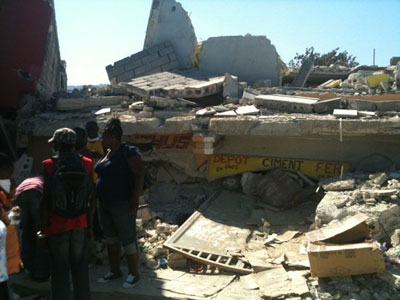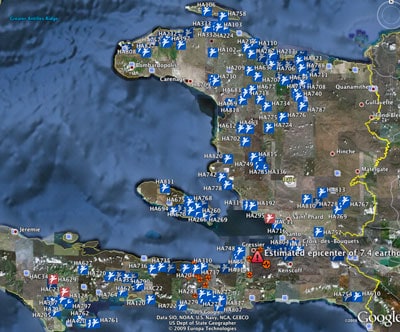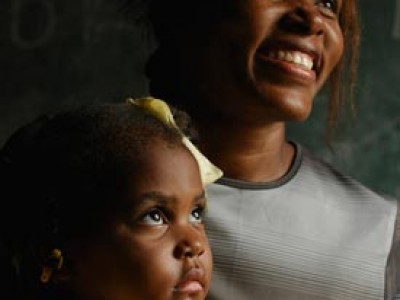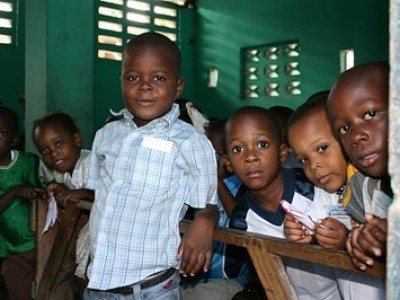Earthquake Pictures From Haiti
UPDATE: Jan. 30, 2010 – The first eight photos are new.
Earthquake pictures from Haiti taken by our staff and contractors. As we receive more pictures, we will upload them to our Haiti Earthquake set on Flickr, which automatically updates this slideshow.
Continue Reading ›It’s Time to Start Over in Haiti
UPDATED: Jan. 22, 2010 – Listen to Tim interviewed by Rodney Olsen on Australia’s 98.5 Sonshine FM.
You can see the photos and video footage on your television or computer, but they don’t do the devastation in Haiti justice.
Building after building has collapsed. I’ve seen dozens of multistory buildings that have collapsed into a stack of pancaked floors. Looking at the sheer tonnage of cement, I’m amazed anyone survived.

Hospitals, schools, churches and businesses all flattened. As if this country didn’t already struggle to provide those services to those who need it. That is the great irony right now. The number of people who need medical attention has increased dramatically as the result of this disaster, but the number of medical clinics and hospitals decreased. It seems so unjust.
Communication and transportation are terrible. I’d love to be able to show you some of the videos that I’ve shot, but I can’t get a strong enough Internet connection to last long enough to upload. At this point, my best connection provides 8kb per second. Terribly slow. And it lasts only a few minutes at a time.
This morning, I witnessed a relief truck get overtaken by a crowd of people in the streets. The people climbed the big rig by the dozens, forcing open the back doors and tossing out bags of rice … all while the truck was driving.
People are desperate for food. All over town, there are makeshift signs (mostly sheets with painted words on them) saying, “We Need Help” or “Please — We Need Food and Water.”
At the border of the Dominican Republic and Haiti, I saw a couple of relief supply trucks that had been turned into makeshift storefronts. People were trying to sell the food, water and clothing inside. Another example of how important it is for you to make sure you partner with an organization that has established distribution channels.
Many organizations can get stuff here, but don’t know how to distribute it. Parking a truck on the side of the road can cause mayhem. (more…)
Continue Reading ›2010 Haiti Earthquake Update
Note: This article is about the 2010 earthquake. Learn how to donate to help children affected by the August 2021 Haiti earthquake.
UPDATED: June 30, 2010 at 1:45 p.m. (MT) – Out of more than 22,000 children affected by the earthquake we are still in the process of locating around 350 children. We are continuing to contact sponsors whose children we do have specific information on.
Our church partners continue to search the tent cities daily to locate the rest of the children. In addition, regionally based partnership facilitators continue to search the countryside to find children who may have relocated outside of the city after the quake.
Classes have resumed in nine of the eleven universities where our Leadership Development Program students are enrolled, 62 students are attending class again. However, 26 of our students for various reasons (sickness linked to the earthquake, stress, trauma, formal interdiction from some parents, etc.) have not returned to school.
Our leadership team is proceeding with the repairs of our three-level office building in Port-au-Prince. Repair work is expected to go until the end of July. A local firm is responsible for the repair but an expert from Engineering Ministries International is in the field for the work supervision.
Two psychologists have been hired for a six-month contract to design a plan to help meet the psychological needs of our registered children, siblings, relatives and church staff members.
Our initial objective for addressing the temporary and transitional shelter needs of our beneficiaries was to provide tarps to 4,000 families in the urban areas, and corrugated metal sheets, wood frames and nails to 2,000 families located in the rural areas.
So far, we have distributed 4,237 tarps to complete the tarp distribution activity. Some families were given two tarps based on need. Also, more than 1,300 families received corrugated metal sheets and wood frames in rural areas. Another 700 will be served as soon as possible.
About 8,000 registered children and 7,000 siblings and parents were seen through our mobile medical clinics. Malaria and typhoid tests have been given to patients who also received medicine, if needed, or are referred to the hospital or a health center for follow-up.
As most of our child development centers also have a school where many of the children attend, our plan to provide transitional meeting places until the damaged centers can be rebuilt is providing school equipment to replace some of what has been lost.
The Haitian government has reopened schools and extended the school term by through August. Most of the schools are allowing children to go home at noon because of the extreme heat, to minimize the amount of time the children are kept under the tarps and canopies.
We are processing letters and gifts for all child development centers in Haiti. If you send a gift, please do not specify how it should be used. It is very difficult for our Haiti staff to follow through with the request.
Until further notice we are not conducting any travel to Haiti (e.g., sponsor visits, individual relief efforts, tours, vision trips, etc.).
All of the affected child development centers have resumed activities, meeting under tarps or tin roofs. All of the significantly affected centers are meeting three times a week.
Although the full scope of regular activities is not currently taking place at child development centers and child survival programs significantly affected by the earthquake, affected church partners are continuing to conduct camps to help address the psychological, physical, nutritional, and cognitive needs of our registered children, as well as the mothers and the babies participating in our Child Survival Program (CSP).
In general, our church partners will host these camps until the development centers are rebuilt or activities can be relocated to a safe indoor location.
Camp activities focus on five areas:
- occupational therapy including art, sports and games
- cognitive therapy including earthquake and natural disaster education
- group therapy for children under 8 years old
- individual therapy for children over 8 years old
- immunization against polio, measles, tetanus and hepatitis A
For the CSP camps, two to three Child Survival Programs are grouped together for efficiency, depending on their geographic location.
Images of Child Development Centers in Haiti
UPDATED: Jan. 29, 2010 – List of child development centers affected by the Haiti earthquake
Here is a Google Earth image showing the approximate location for the earthquake’s epicenter in relation to our child development centers.
The image is just intended to give perspective not definitively identify where all the centers are located. However, there is a discussion thread in Facebook about the location of some centers.
The fact that many development centers are so close to one another means that some centers can’t be seen. And obviously the size of the image makes it difficult to read the numbers that are visible. We published a larger image in Twitpic and in Facebook.
The blue icons represent child development centers, and the red icons represent child survival programs. Most red icons hide behind the blue ones, but for some reason a few show through.
The orange circles represent earthquake activity in the last week (or so).

Here is an additional Google Earth image that highlights a 750 square mile section of Haiti relative to the earthquake so you can more clearly see which child development centers are closest to the epicenter. (more…)
Fighting the Restavèk Curse in Haiti
Restavèk is a Creole word for a Haitian child who stays with and works for another family. A restavèk child can be a boy or a girl who is given away by a poor family in order to survive. Frequently, the restavèk’s most basic rights to health and education are denied.
Of these children, 65 percent are girls between age 6 and 14. They are forced to work long hours under harsh conditions and are subject to mistreatment, including sexual abuse.
The restavèk child is the first person to wake up in the morning and the last one to go to bed, sometimes after 14 hours of work that consists of, among other chores, carrying water, washing clothes, taking the owner’s children to school, doing errands, and cleaning the home.
The restavèk child is often beaten for the simplest mistakes. Laws against child abuse exist in Haiti, but unfortunately, they are seldom enforced as children’s rights don’t have a high a priority.
The number of restavèk children reported nationally is between 250,000 and 300,000, and this domestic phenomenon is due to several reasons. (more…)

Ti Chape
It’s a Creole phrase that many parents in these poorest areas of Haiti use with their youngest kids. I’m sure you’ll hear it often over the next several days as we visit homes. It’s a term of endearment … but also a harsh reality that reminds everyone of how devastating each day can be for people living on the brink. Ti Chape means little survivor or one who has escaped death

A Day in Port-au-Prince
The first thing you notice when you wake up in Port-au-Prince is the smoke. Your eyes sting, and it feels as though you’ve had a smoky cloth held over your mouth all night from the Haitians’ cooking fires.


